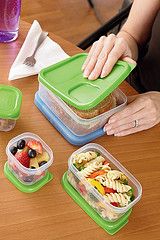
Food storage containers don’t rank in the A-list of kitchen gadgets like sleek Kitchen Aid stand mixers and shiny All-Clad cookware. In fact, a lot of us muddle by with a random assortment of yogurt cups and take out tubs–with dozens of even more random lids that never seem to fit anything. Hence this article.
If you are interested in meals with any of these attributes–healthy, efficient, affordable, stress-free and/or tasty–then you need decent storage containers. The yogurt cups and take out tubs can (mostly) be recycled. So recycle them now and get a set of sturdy containers that will last for years. The rewards are many:
- Enjoy Efficiency: Absolutely begin doubling the amount of pasta, sweet potatoes, potatoes, rice, chicken, etc., etc., that you cook. Extras stored in good containers will last perfectly for days, giving a good head start on later meals.
- Get Healthy: The previous trick is especially helpful when it comes to vegetables. As long as you’re set up for washing and chopping, cut and store extras (vegetables hold up quite nicely in tight-seal containers.) Then see if you don’t find more vegetables weaving their way into your meals.
- Save on Stress: Square containers are the best because they stack conveniently and maximize space in the frig. They leave the refrigerator organized, with everything easy to view and remove.
- Save Money: Americans pitch enormous amounts of food. Instead of pitching, start capturing leftovers in convenient storage containers and see what affordable (and healthy) snacks and lunches they make. Plus, when I finally started transporting our foods in actual containers, I no longer lost food that exploded and leaked from unreliable yogurt cups.
- Please Your Kids: Homemade lunches ensure that your kids’ mid-day meals are healthful. Good storage containers ensure that lunch won’t be splattered all over their lunch boxes–and it minimizes waste.
No question about it, good storage containers are an essential. But maybe you’re having a couple nagging questions:
- What about plastic containers–are they safe? Valid concern, with all the press lately about the dangers of plastic. This is my solution to date: I use glass for storing hot leftovers and reheating in a microwave; tight-seal plastics for transporting foods and storing vegetables.
- How many containers do I need? If you’re just starting out, 15-20 pieces is not too much, since some will always be in use in the frig and some will be in the wash cycle. Should it prove too much, pass some along to a friend or child setting up house. Alternatively, they can be used to store and organize an array of other household items, from batteries and crafting supplies to nails and sprinkler parts.